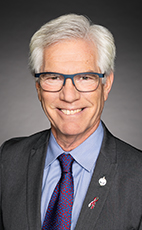44th Parl. 1st Sess.
June 1, 2022 02:00PM
- Jun/1/22 2:05:32 p.m.
- Watch
Mr. Speaker, I recently joined the Deputy Prime Minister, Minister of Northern Affairs, my Manitoba colleagues and Premier Heather Stefanson to greet 350 Ukrainian adults and children and their pets as they arrived in Winnipeg.
We greeted them like family, which is not an exaggeration. More than 120,000 Manitobans are of Ukrainian descent, including members of my own family. Each of them received a warm Manitoba welcome.
However, those moments of warm embrace were bittersweet. Thoughts of beloved family, friends and homeland left behind were ever-present. Vladimir Putin is solely to blame for the chaos, for displacing millions of people and taking thousands of lives. He has waged an illegal war on a democratic nation and is terrorizing civilians and razing cities.
Ukraine is a significant ally to NATO, and as a member of the alliance, Canada will continue to support its defence through humanitarian aid and military equipment for as long as necessary. Canada will always be a steadfast supporter of Ukraine and host its people with warmth, dignity and respect.
174 words
- Hear!
- Rabble!
- add
- star_border
- share
- Jun/1/22 2:57:17 p.m.
- Watch
Mr. Speaker, as the member opposite well knows but will not share with his constituents or any Canadians, the price on pollution actually returns more money to the average Canadian family than it costs in many places where it has been brought in. We are talking about over $1,000 a year for families in Saskatchewan and Alberta and $800 or so in Manitoba.
We will continue to make sure we are supporting Canadians, even as we move beyond our reliance on fossil fuels. This is something we know the world is asking for and Canadians are asking for, and we are leading on it despite Conservative—
108 words
- Hear!
- Rabble!
- add
- star_border
- share
Mr. Speaker, I am proud to rise to speak to Bill C-248, a bill that would create Ojibway national urban park near Windsor, Ontario, put forward by the member for Windsor West. This initiative would combine lands owned by the federal government, the provincial government and the City of Windsor to form a priceless package that would protect an endangered ecosystem unique to Canada.
To answer the question put forward by the member for Avignon—La Mitis—Matane—Matapédia as to why the federal government should be involved, it is because it is a national treasure. This is an area that is unique in Canada, not just in Windsor, not just in Ontario, but in Canada.
I would like to thank the member for Windsor West for the tireless work he has put in on this file. The previous speaker mentioned that the work he has done has been going on for almost 10 years to get to this point. I have to thank him also for inviting me to Windsor a few years ago to visit the site. He gave me the full tour.
It was a beautiful weekend in September, so we walked the trails of several properties, through fields of big bluestem grass, which is also called turkey-foot because of the way seed pods grow. We also walked through groves of oak trees, late summer flowers and, of course, a diverse array of birds and other wildlife.
The member for Essex mentioned how valuable this would also be for the local residents and visitors. Since the pandemic, I have a seen a huge increase, as I am sure every other member here has, in people going into the outdoors in their ridings and visiting parks. We need these spaces for people to get out and go to.
Some might ask why a relatively small collection of properties deserve the status of a national park, when they are only about 900 acres in all, adjacent to the urban industrial areas of Windsor and just across the river from the urban industrial sprawl of Detroit. Ojibway national urban park would preserve some of the last and best remnants of once much larger ecosystems: the tall grass prairie, oak savannas and the Carolinian forest.
In my previous life, I was a biologist. Much of the work I did in that career was centred around endangered ecosystems and species at risk. There are four ecosystems in this country that are consistently listed as the most endangered ecosystems in Canada. They are the Garry oak savannas of southeastern Vancouver Island and the Gulf Islands in British Columbia; the desert grasslands of the southern interior of British Columbia, which is my home habitat; the Carolinian forest of southern Ontario; and the tall grass prairie of southeastern Manitoba and southwestern Ontario.
An Ojibway national urban park would protect two of these critically endangered ecosystems. We do not often think of Ontario as a prairie province, but it once had extensive tall grass prairies throughout southern Ontario. Over the past three centuries, those prairies have almost been completely wiped out by agriculture and development. Only 1% of those habitats now remain in scattered remnants from Essex county north to the Rice Lake plains. There are only three relatively large protected prairie remnants in Ontario, and when I say “large”, I am talking about more than just a few acres. There is the Alderville Black Oak Savanna near Rice Lake, Bronte Creek Provincial Park and the Ojibway Prairie Complex. The Ojibway Prairie is a significant part of the national park this bill would create.
Endangered ecosystems are almost, by definition, home to long lists of species at risk, and I would like to talk about some of them now. There are 160 provincially rare species in the Ojibway Prairie area. No other area in Ontario has such a concentration of rare species, and only one or two areas in Canada can match this concentration of rarity. One of those areas, I have to add, is the desert grasslands in my riding.
One hundred and nineteen of these rare species are plants at Ojibway Prairie and 19 of those species are federally listed. They are listed in the Species at Risk Act. That includes the American chestnut and the Kentucky coffee tree. Another endangered plant is the scarlet ammannia, which I have to point out is only found in two places in Canada. One is in Ojibway Prairie and the other is at Osoyoos, British Columbia, in my riding.
These rare plant communities are obviously home to thousands of species of insects, many of which we know little about. For many, we do not even have good, basic survey information, let alone know how important they are to broader ecosystem function.
Since we do not talk very often in this place about beautiful insects, I have to take a moment to talk about at least one species found in the area in question, and that is the giant spreadwing.
As I am sure everyone knows, dragonflies come in two groups: the big dragonflies that rest with their wings open and the smaller damselflies that rest with their wings closed. There is another group in the middle, the spreadwings, that rest with their wings open as well. The biggest of that group is the giant spreadwing. The only place in Canada it is found is Ojibway Prairie.
There are endangered reptiles. The member for Essex mentioned the eastern foxsnake. There are also Blanding's turtle, Butler's gartersnake and the massasauga rattlesnake. I am not sure what he would think if he came across one of those, but it is a rattlesnake population that is isolated from other Canadian populations by over 300 kilometres, and it is on the brink of local extinction.
Some endangered species, such as the northern bobwhite and the five-lined skink, have disappeared from the Ojibway Prairie area. That is what happens when we let endangered ecosystems become too fractured and too small for populations to maintain themselves.
The bobwhite is an iconic quail species that was once common throughout much of eastern North America. It became rarer in Canada during the 20th century as prairie and savanna habitats were developed for intensive agriculture and housing and altered by afforestation. Its Canadian population collapsed in the 1990s and it is no longer found even on the Ojibway Prairie. The only existing population in Canada is on Walpole Island, northwest of Windsor.
A natural area need not be as large, as spectacular or as pristine as Banff, Jasper or Kluane to deserve protection as a national park. Ojibway Shores and surrounding areas are clearly deserving of this protection. The biodiversity and rare ecosystems there are a national treasure. The fact that the remaining areas of intact habitat are small, dissected by roads and surrounded by farmland, industrial sites and suburban neighbourhoods is no reason to abandon them to further development.
That is almost what happened to Ojibway Shores. In 2013, the Windsor Port Authority planned to clear-cut the forest and fill the Ojibway Shores property for development. The member for Windsor West fought to stop this action, and over the course of several years led a successful battle to convince the federal government to preserve the property.
I would like to stress one other thing that makes this such an important proposal. This national urban park would bring together properties that would provide connectivity from the Detroit River and its shoreline habitats through woodlands and savannas, to upland woodlands and prairies.
Connectivity is a critical part of maintaining the integrity of rare habitats, especially as they become fragmented into smaller pieces. If any one of the parcels that is a part of this proposal is lost to development, it would negatively impact the rest of the parcels. It is critical that they be protected together.
I would be remiss if I did not mention that there is a national park proposal in my riding: in the South Okanagan area of British Columbia. Like Ojibway, this is an ecosystem unique in Canada in a fragmented landscape. It is a mosaic of Crown land, first nations land, municipalities and private land.
This initiative has been debated in my riding for over 20 years, and is now in the negotiation stage among first nations and federal and provincial governments. Because of the diversity of the land ownership in this landscape, those negotiations represent a delicate balance between the need for strong protection of nationally significant ecosystems and respecting the concerns of the broader community and the livelihoods of those who depend on the grasslands, such as ranchers.
Like Ojibway, this would not be a park like Jasper or Banff, but a park designed for the unique circumstances of the South Okanagan. The Ojibway national urban park proposal has the full backing of the Caldwell First Nation and the City of Windsor, as the member for Essex mentioned. It would be a jewel in the crown of our national park system and I fully support this bill.
In closing, I would simply like to thank the member for Windsor West once again, and thank all of those who have worked so hard, often against all odds, to make this happen.
1552 words
All Topics
- Hear!
- Rabble!
- add
- star_border
- share
- menumenu
- notificationsnotifications
- home
- mailmail
- searchsearch





